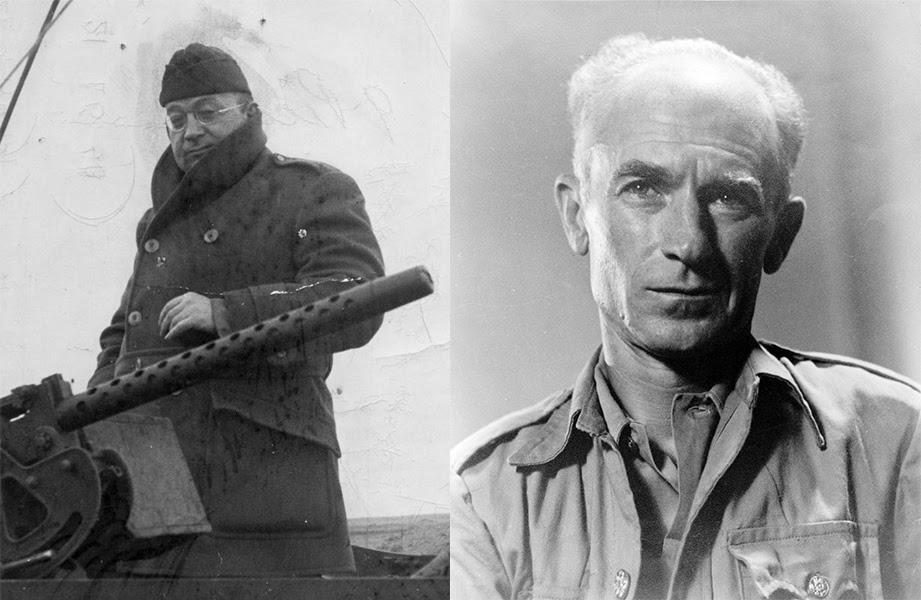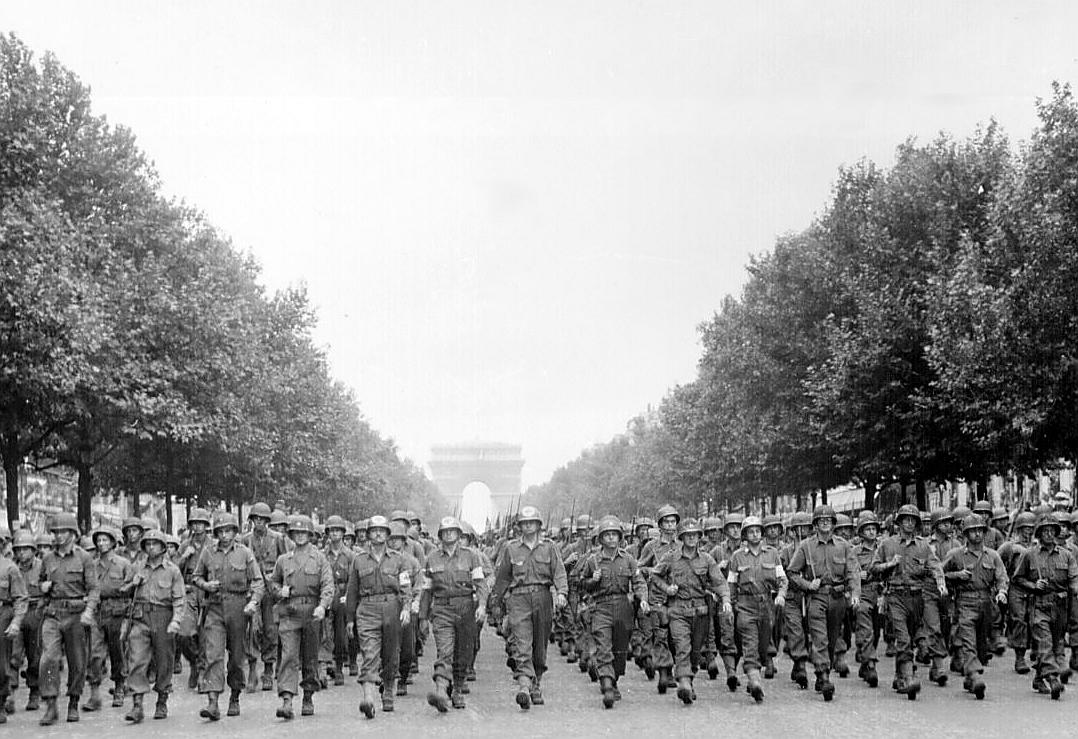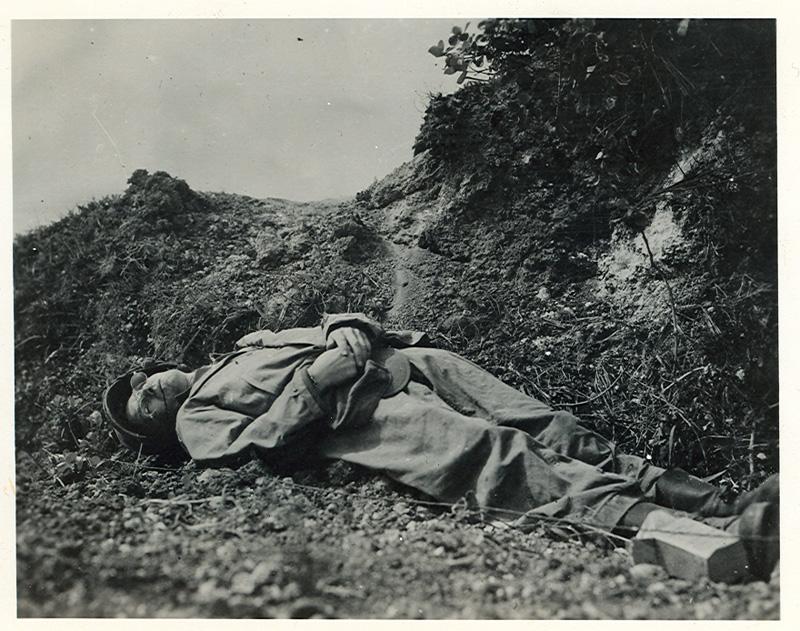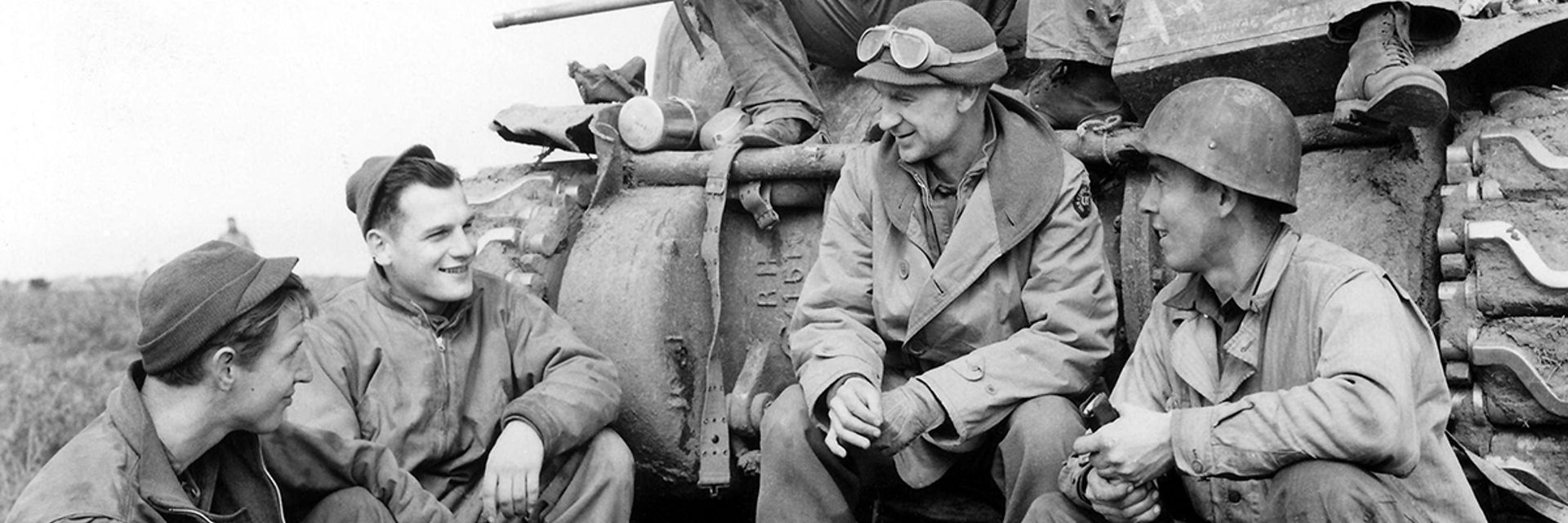In covering the American Army’s World War II North Africa campaign, two writers introduced a new intimacy and sympathy to war reporting. Ernie Pyle and A.J. “Joe” Liebling focused on the everyday details faced by soldiers on the march and under fire. They told of their own fears and close calls, and illustrated the character and endurance of the young men sent to fight and die. In describing the deadly everydayness of the front, Liebling and Pyle debunked a grand view of war, while illustrating the small acts of heroism that characterized every soldier’s service.
◊
When the U.S. Army landed in North Africa in March 1943 to begin Operation Torch, it initiated not just American combat against Nazi Germany, but a new era in how war was reported to the people back home.
Three years earlier, radio brought the drama and horror of the London Blitz – most forcefully with the eyewitness accounts of Edward R. Murrow – to U.S. listeners. Large-format photo magazines, Life and Look, which appeared in the previous decade, published intimate and graphic views of the war in Europe in the two years before Pearl Harbor.
There was room, then, for personal and moving accounts of what U.S. servicemen experienced: the carnage and elation, the boredom, exhaustion, and simple joys of soldier life, to accompany the traditional reports of the order of battles and the views of generals.
Two reporters with the Army in North Africa filed stories, then produced books drawn from their work at the front, redefining war reporting. Those men, Ernie Pyle, and A. J. “Joe” Liebling, could not have been more unalike. Pyle was a thin 43-year-old from a tiny Indiana town. Liebling, three years his junior, was a native New Yorker whose hefty frame reflected the robust pleasure he took from eating.
Pyle’s prematurely gray hair and soft, sympathetic gaze gave him the look of a Methodist minister. His column for the Scripps-Howard newspaper chain was read by 30 million people. Liebling more resembled the bookies, fight promoters, and Times Square conmen he loved writing about in breezy articles for The New Yorker. The weekly magazine had a much smaller, but more widely influential, readership.
Both men worked for years on daily newspapers, Pyle in the heartland, Liebling in Manhattan. Both of them were unlikely foreign correspondents, but were sent by their employers to cover the London Blitz and then the American campaign in North Africa. Both published books soon after it ended. Pyle’s Here is Your War (1943) was an immediate bestseller. Liebling’s The Road Back to Paris (1944) had respectable sales. Both are still in print, genuine classics of American literature.

A.J. Liebling and Ernie Pyle in their correspondent’s uniforms. (Credits: Cornell University Library; Wikipedia)
Two Old Soldiers, and a New Way to Report the War
In North Africa the two were attached to the First Infantry Division, and were personally drawn to its commander, Major General Terry de la Mesa Allen, an old-school cavalry officer, and his associate, a fellow World War I vet, Brigadier General Teddy Roosevelt Jr.
Allen had flunked out of West Point, and was a former prizefighter, exactly Liebling’s type of guy. “Allen,” Liebling recorded, “who at first meeting appears to be a slapdash, reckless sort of fellow; perhaps because of his old line cavalry personality and mannerisms, is in fact a worrier. He felt that things were going too well to be on the level.”
Roosevelt “likes to circulate among the units in action during a battle. . . . His staccato, gamecock walk serves to identify him as long as he is within field glass range. . . . [They] take on a new and attractive quality when they are exhibited under fire.”
For Pyle, “Allen was one of my favorite people. Partly because he didn’t give a damn for hell or high water; partly because he was more colorful than most; and partly because he was the only general . . . I could call by his first name. . . . He had been all shot up in the last war, and he seemed not the least averse to getting shot up again.”
Pyle took Allen’s example to heart and lived as a foot soldier whenever he could. Where Liebling and the other correspondents traveled around the battle zone, Pyle would sit for days with the same men, eating (or going hungry) when they did; sleeping (or not) as they did. His accounts of their lives, giving, when censors allowed, the names and hometowns of the soldiers he met, made him revered among enlisted men.
“The danger came in spurts: discomfort was perpetual,” he wrote. “Dirt and cold were almost constant. . . . A man just sort of existed, either standing up working or lying down sleeping. There was no pleasant in between.”
Defeat at Kasserine, Then Victory at El Guettar
Pyle was with the First Infantry for the Army’s initial, disastrous, encounter with General Field Marshal Erwin Rommel’s Afrika Korps at the Kasserine Pass. The crack German force made short work of the inexperienced U.S. units that, nevertheless, made an orderly retreat through the pass.
Rommel did not pursue the Americans, instead turning to face the British forces commanded by Field Marshal Bernard Montgomery, moving on the Afrika Korps from the East.
Tellingly, Pyle did not mention the heavy loss of life at Kasserine, reporting instead on the withdrawal as an example of courageous fortitude:
“Our great brown vehicles rumbled past – one about every 30 seconds – for 24 hours. First, before daylight, came the kitchen trucks and engineers. . . . Then came rolling guns, and some infantry to set up protection along the roads. Then the vast great bulk of long supply trains and finally – when night came again – the tanks started and moved on until the next dawn. . . .
“It simply could not have been done better . . . [our] humiliation was somewhat overcome by our pride in the orderliness of the accomplishment.”
Liebling was away on break for the Kasserine defeat. Unlike Pyle, he enumerated the American losses in his own terse account. “We had lost almost all of two battalions of armor and two battalions of infantry . . . and I was rather glad I missed it. I had had my bellyful of retreat in France.”
Pyle was on break in late March 1943 when the Americans pushed into the El Guettar valley, drawing Rommel’s army into a battle that resulted in the first American victory of the war.
Liebling, who was there, describes the peculiar nature of observing widespread motorized desert warfare: “Matthews looked through his binoculars and saw a couple small dots creeping hesitantly towards us. . . . He said they were tanks. They came nearer, very indirectly and with frequent halts, until they got as big as bedbugs on a wall, and then geysers of black smoke and dirt began to appear near them. . . . The geysers were shell bursts; our howitzers, firing from their position back of the ridge we held, were shooting at them.”
He ends his book on North Africa with a bookie’s calculation: “If one American division could beat one German division, I thought then, a hundred American divisions could beat a hundred German divisions. Only the time was already past when Germany had a hundred divisions to spare. . . . I knew deep down inside me after that that the road back to Paris was clear.”
In the following year, Pyle’s renown was forever fixed when, in quick succession, he was awarded a Pulitzer Prize, and Congress passed what was called the Ernie Pyle bill. In one of his columns from the Italian front, he had wondered why soldiers did not get extra pay for combat. The Pyle bill, granting the money, was passed only months later.
Witnesses to D-Day
Both reporters moved on after Operation Torch. Liebling spent several months in the States. Pyle, characteristically, had stayed with the troops through the bitter Italian campaign. In May ‘44, He was called back to England from the hellish battle of Anzio. He and Liebling, now in London, had been assigned to cover the first wave of landings on D-Day.
Liebling reported from a flat-bottomed landing boat that delivered soldiers to the beachhead. “I felt the ship ground. I looked down on the main deck, and the beach-battalion men were already moving ahead, so I knew the ramps must be down. I could hear Long shouting ‘Move along now! Move along!’ As if he were unloading an excursion boat at Coney Island. But the men needed no urging; they were moving without a sign of flinching. You didn’t have to look far for tracers now. . . .”
Pyle, on another landing craft, filed a D-Day +1 report on the vast material resources – and losses – of the Allied landing. Ten days later he wrote possibly the greatest account of the aftermath of battle, heartbreaking to read to this day:
“But there is another and more human litter. It extends in a thin little line just like a high-water mark, for miles along the beach. This is the strewn personal gear, gear that will never be needed again, of those who fought and died to give us our entrance into Europe.
“Here in a jumbled row for mile on mile are soldiers’ packs. Here are socks and shoe polish, sewing kits, diaries, Bibles, and hand grenades. . . . Here are toothbrushes and razors, and snapshots of families back home staring up at you from the sand . . .”
Both Pyle and Liebling stayed with the troops in the sweep through France and the liberation of Paris, bivouacking together with other reporters. Apparently Pyle cooked the food that Liebling and their colleagues managed to scavenge from nearby farms.

American troops parade down the Champs Elysees in August 1944 (Source: Wikipedia)
The liberation of Paris in August 1944 was a turning point for both. Liebling, a lifelong Francophile, who fell in love with French cooking as a student in Paris, and, in 1940, fled the city ahead of the Nazi advance, was enraptured: “For the first time in my life,” he wrote, “and probably the last, I have lived for a week in a great city where everyone was happy.”
Pyle, hardened by the two years spent in grueling conditions, was dismayed by the celebrations, and privately likened the experiences that week to living in an enormous bordello.
The Bitter Toll of War
Pyle and Liebling returned to the States in late ’44. Pyle was clearly exhausted, and apologized to readers for what’s recognized today as a full-blown case of PTSD. “My spirit is wobbly and my mind is confused. . . . All of a sudden, it seemed to me that if I heard one more shot or saw one more dead man, I would go off my nut.”
That November, Liebling was crushed to learn that the young writer sent by The New Yorker to replace him was killed when his Jeep hit a mine. He blamed himself. “I felt like crying rather than writing,” he told a colleague. “The same thing would never have happened to me. It was only because of his inexperience that he was killed.”
Though completely worn out, Pyle reluctantly agreed to ship out to cover the Pacific theater. After way-too-many close calls with death in Europe, he told friends he did not expect to return. He was killed by Japanese machine gun fire on the island of le Shima on April 17, 1945, and is buried at the National Memorial Cemetery of the Pacific in Honolulu.
Liebling died in late 1963, effectively eating and drinking himself to death. However, in the nearly two decades after the war he wrote The Sweet Science (1956), a volume on boxing that Sports Illustrated judged to be the greatest sports book ever, as well as a landmark work of food writing, Between Meals (1962), and Chicago: The Second City (1952), the book that gave the Windy City its other famous nickname.
In 2008, a photo showing Pyle’s dead body was discovered. Taken by a Marine Corps photographer, Pyle reclines under a small hill, hands folded as if asleep, only the odd angle of his head, broken eyeglasses, and a small trickle of blood from the corner of his mouth reveal the truth. News organizations decided to publish this deeply sad image to remind later generations of Pyle’s work reporting the human cost of war. No one doubted that Ernie Pyle would’ve been the first to say “Print it.”

Ernie Pyle lying dead. (Source: Wikimedia Commons)
Ω
Title Image: Ernie Pyle visits with members of the 191st Tank Batalllion at the Anzio beachhead ca. May 1944. (Source: Wikipedia)

